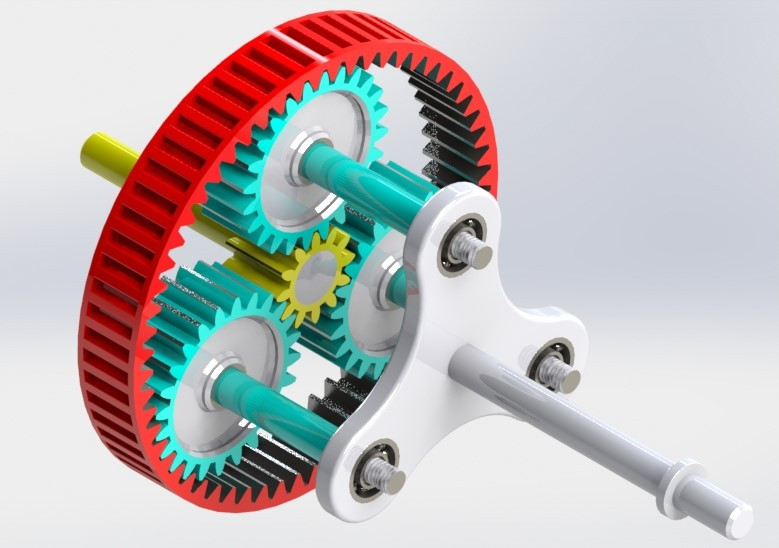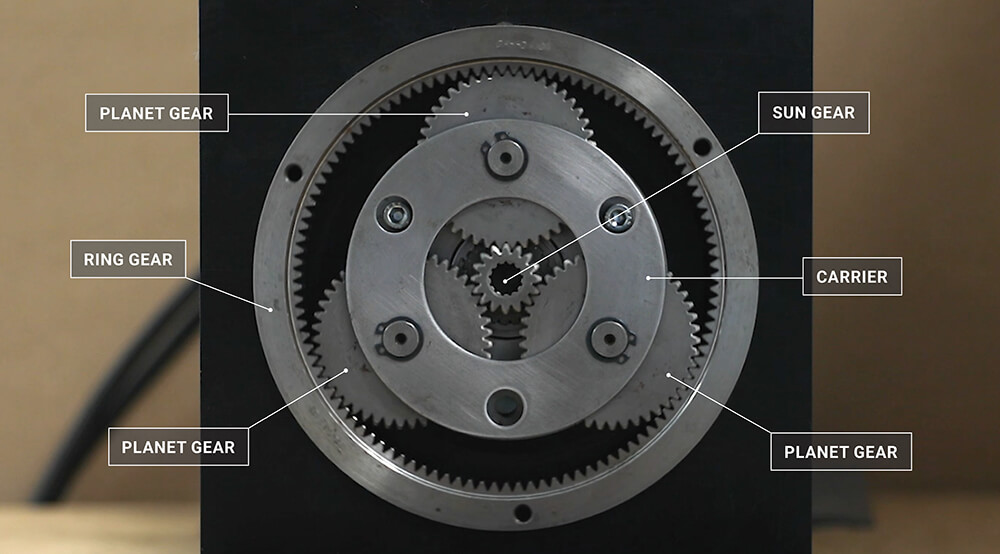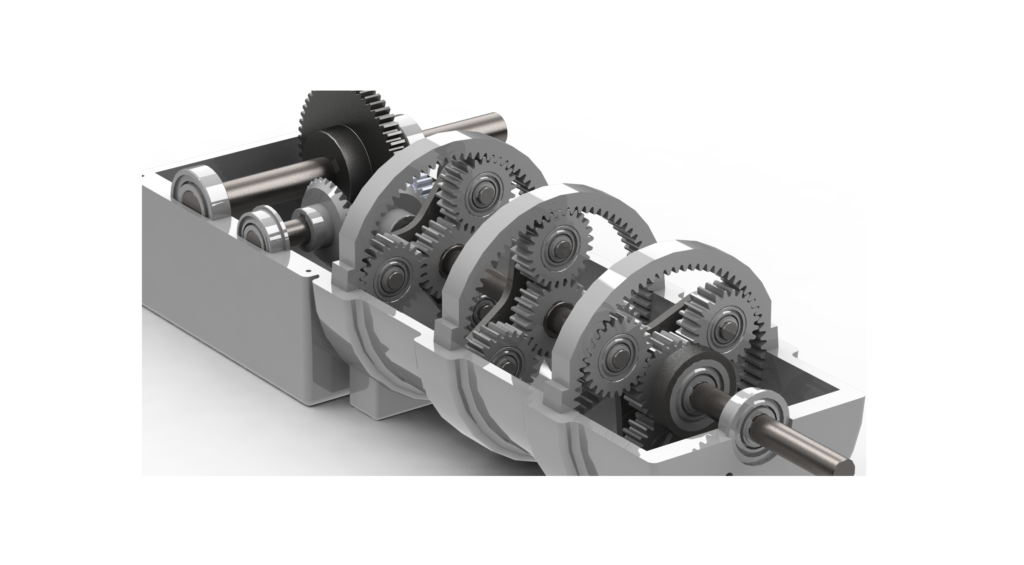Product Description
Product Description
NGW Series Planetary Speed Gear rducer
NGW series gearboxes consist of single-stage(NGW11-NGW121),two-stage(NGW42-NGW122) and stree-stage(NGW73-NGW123).
1.Model Number
NGW, NGW-L, NGW-S, NGW-QJ
2.Applications
NGW Planetary Gear Units is widely used in many areas such as metallurgy, mine, lifting, transportation, textile, cement, light industry, chemical, pharmaceutical, dye printing and so on.
Detailed Photos
3.Product Characteristics
(1) Small volume, light weight, well-knitted structure, big transmission power and high load capacity. Compared with the ordinary cylindrical gear reducers of the same level, its weight is lower 1/2 and volume is only 1/2-1/3 of the former.
(2) High transmission efficiency. 1-stage is up to 97%, 2-stage 94%, 3-stage 91%.
(3) The range of transmission power is very wide, from 1kw to 1300kw.
(4) NGW Planetary Gear Units is designed with hard-tooth-faced, and can be used widely and in long period.
(5) Big transmission ratio
4.Technical Data(NGW)
Original Version NGW Series
Shafts Position: In Line
1 Stage: NGW11~NGW121 Ratio: 2.8~12.5
2 Stage: NGW42~NGW122 Ratio: 14~160
3 Stage: NGW73~NGW123 Ratio: 180~2000
New Design NGW Series
Shafts Position: In Line, Parallel Shaft
NAD(NAF) – 1 Stage, Foot Mounted(Flange Mounted), In Line
NAZD(NAZF) – 1 Stage, Foot Mounted(Flange Mounted), Parallel Shaft
NBD(NBF) – 2 Stage, Foot Mounted(Flange Mounted), In Line
Product Parameters
NGW-S Series Planetary Gearboxes
Shafts Position: Right Angle
Gearset: Spiral Bevel Gear Pair Integrated With Planetary Gear Set
2 Stage: NGW-S42~NGW-S122 Ratio: 11.2~80
3 Stage: NGW-S73~NGW-S123 Ratio: 56~500
| Stage | Model | Size | Ratio | Rated Power |
| Single-stage | NGW11~NGW121 | 1~12 | 2.8~12.5 | 2. 8-1314KW |
| Two-stage | NGW42~NGW122 | 1~12 | 14-160 | 0.7-517KW |
| Three-stage | NGW73~NGW123 | 1~6 | 180-2000 | 0.16-47.1KW |
| Types | Sizes | Nominal Ratio | Input Shaft Dia.(m6) | Output Shaft Dia.(n6) |
| NAD | 200,224,…1800,2000 | 4~5.6
6.3~9 |
50~400mm
40~360mm |
60~630mm |
| NAF | 200,224,…500,560 | 4~5.6
6.3~9 |
50~130mm
40~100mm |
60~220mm |
| NAZD | 200,224,…1400,1600 | 10~18 | 30~240mm | 60~560mm |
| NAZF | 200,224,…500,560 | 10~18 | 30~85mm | 60~220mm |
| NBD | 250,280,…1800,2000 | 20~25
28~50 |
30~280mm | 80~630mm |
| NBF | 250,280,…500,560 | 20~25
28~50 |
30~80mm | 80~220mm |
| NBZD | 250,280,…1400,1600 | 56~125 | 28~170mm | 80~560mm |
| NBZF | 250,280,…500,560 | 56~125 | 28~55mm | 80~220mm |
| NCD | 315,355,…1800,2000 | 112~400 | 25~150mm | 120~630mm |
| NCF | 315,355,…500,560 | 112~400 | 25~50mm | 120~220mm |
| NCZD | 315,355,…1800,2000 | 450~1250 | 20~170mm | 120~630mm |
| NCZF | 315,355,…500,560 | 450~1250 | 25~45mm | 120~220mm |
Packaging & Shipping
Company Profile
After Sales Service
| Pre-sale services | 1. Select equipment model. |
| 2.Design and manufacture products according to clients’ special requirement. | |
| 3.Train technical personal for clients | |
| Services during selling | 1.Pre-check and accept products ahead of delivery. |
| 2. Help clients to draft solving plans. | |
| After-sale services | 1.Assist clients to prepare for the first construction scheme. |
| 2. Train the first-line operators. | |
| 3.Take initiative to eliminate the trouble rapidly. | |
| 4. Provide technical exchanging. |
FAQ
1.Q:What kinds of gearbox can you produce for us?
A:Main products of our company: UDL series speed variator,RV series worm gear reducer, ATA series shaft mounted gearbox, X,B series gear reducer,
P series planetary gearbox and R, S, K, and F series helical-tooth reducer, more
than 1 hundred models and thousands of specifications
2.Q:Can you make as per custom drawing?
A: Yes, we offer customized service for customers.
3.Q:What is your terms of payment ?
A: 30% Advance payment by T/T after signing the contract.70% before delivery
4.Q:What is your MOQ?
A: 1 Set
If you have any demand for our products please feel free to contact me.
| Application: | Machinery |
|---|---|
| Function: | Speed Changing, Speed Reduction |
| Layout: | Coaxial |
| Installation: | Horizontal Type |
| Step: | Double-Step |
| Type: | Planetary Gear Box |
| Customization: |
Available
| Customized Request |
|---|

How do planetary gears handle changes in speed and torque distribution?
Planetary gears are capable of effectively handling changes in speed and torque distribution due to their unique design and configuration. Let’s explore how planetary gears handle these changes:
- Speed Changes:
Planetary gears can handle speed changes by utilizing the different gear ratios they offer. By adjusting the sizes and numbers of teeth on the sun gear, planet gears, and ring gear, different gear ratios can be achieved. When the input speed is applied to the sun gear, it gets transmitted to the planet gears, resulting in a specific output speed. By changing the gear ratio, the output speed can be adjusted accordingly. This ability to vary the gear ratio allows planetary gears to adapt to different speed requirements in mechanical systems.
- Torque Distribution:
Planetary gears excel in distributing torque across multiple gear teeth, ensuring efficient torque transmission and load sharing. The planet gears are meshed with both the sun gear and the ring gear, enabling torque to be transmitted through multiple contact points simultaneously. This distributed torque distribution helps in reducing stress on individual gear teeth and enhances the overall torque-carrying capacity of the gear system. The load is shared among the planet gears, preventing excessive wear and minimizing the risk of gear failure.
- Torque Amplification:
Planetary gears can also handle torque amplification, allowing for increased torque output compared to the input torque. By fixing the ring gear and inputting power to the sun gear, the planet gears rotate and contribute to multiplying the torque. The arrangement of multiple gear sets in a compact design enables torque amplification, making planetary gears suitable for applications that require high torque output while maintaining a smaller physical size.
- Load Balancing:
Another aspect of torque distribution in planetary gears is load balancing. The planet gears distribute the load across multiple gear teeth, reducing the concentration of forces on individual teeth. This load balancing capability results in improved gear system durability and longevity. It also helps in minimizing vibration, noise, and wear, ensuring smoother and more reliable operation.
- Flexible Configuration:
Planetary gears offer flexibility in their configuration, allowing for the accommodation of changes in speed and torque distribution. The number of planet gears, the size of the gears, and their arrangement can be adjusted to meet specific application requirements. This flexibility enables planetary gears to handle a wide range of speed and torque variations, making them adaptable to different mechanical setups.
In summary, planetary gears handle changes in speed and torque distribution through their ability to adjust gear ratios, distribute torque across multiple gear teeth, amplify torque, balance loads, and accommodate flexible configurations. These characteristics make planetary gears suitable for applications that require precise control over speed and torque, efficient power transmission, and reliable performance.

How do planetary gears handle variations in direction and torque transmission?
Planetary gears are versatile mechanisms that can effectively handle variations in direction and torque transmission. Let’s explore how they achieve this:
- Direction Reversal:
Planetary gears are capable of transmitting torque in both forward and reverse directions. By changing the input and output connections, the direction of rotation can be reversed without the need for additional components or complex mechanisms. This makes planetary gears well-suited for applications where frequent changes in direction are required, such as automotive transmissions.
- Torque Amplification and Reduction:
One of the notable characteristics of planetary gears is their ability to amplify or reduce torque depending on the arrangement of gear components. Let’s consider a basic arrangement with a sun gear, planet gears, and a ring gear:
- Torque Amplification:
When the sun gear is the input and the ring gear is the output, the planet gears rotate on their own axes while also revolving around the sun gear. This arrangement allows for torque amplification, meaning the output torque can be higher than the input torque. This is particularly useful in applications where higher torque is required, such as heavy machinery or power transmission systems.
- Torque Reduction:
Conversely, by fixing the ring gear and using the sun gear as the output, the planet gears rotate on their own axes while also revolving around the fixed ring gear. In this configuration, the output torque is lower than the input torque, enabling torque reduction. This can be advantageous in applications where torque needs to be reduced, such as speed reduction systems or precision machinery.
- Combination of Gear Stages:
Planetary gears can be combined into multiple stages, with each stage having its own set of sun gears, planet gears, and ring gears. This arrangement allows for further variations in torque transmission. By connecting the output of one stage to the input of another, the torque can be further amplified or reduced, providing flexibility in power transmission systems.
- Custom Gear Ratios:
By selecting the appropriate sizes and numbers of teeth for the sun gears, planet gears, and ring gears, custom gear ratios can be achieved in planetary gear systems. This allows for precise control over torque transmission and enables the adaptation of the gear arrangement to specific application requirements.
In summary, planetary gears handle variations in direction and torque transmission through their ability to reverse direction without additional components, torque amplification or reduction based on gear arrangement, combination of multiple gear stages, and the ability to achieve custom gear ratios. These features make planetary gears a versatile choice for a wide range of applications requiring efficient and flexible power transmission.

What industries commonly use planetary gears in their applications?
Planetary gears find applications in a wide range of industries and mechanical systems. Let’s explore some of the industries that commonly utilize planetary gears:
- Automotive Industry:
The automotive industry extensively uses planetary gears in various applications. Planetary gears are commonly found in automatic transmissions, where they enable smooth gear shifting, provide different gear ratios, and transmit torque efficiently. They are also used in differential systems, allowing wheels to rotate at different speeds while maintaining power distribution.
- Robotics and Automation:
Planetary gears play a crucial role in robotics and automation systems. They are employed in robotic joints and actuators to provide precise motion control, compact size, and high torque transmission. Planetary gears enable robotic arms to move accurately and handle heavy loads, making them essential components in industrial robots and robotic manipulators.
- Aerospace and Aviation:
The aerospace and aviation industries utilize planetary gears in various applications. They are used in aircraft landing gear systems, where they provide reliable torque transmission and compact design. Planetary gears are also employed in aircraft engine systems, helicopter rotor systems, and satellite mechanisms due to their efficiency, high torque capacity, and ability to operate in space-restricted environments.
- Power Generation:
Planetary gears are utilized in power generation equipment, including wind turbines and hydroelectric generators. In wind turbines, planetary gears enable the conversion of low-speed rotor rotation to high-speed generator rotation, ensuring efficient power generation. They are also employed in hydroelectric generators to transmit power from turbines to electrical generators, providing gear reduction and torque amplification.
- Industrial Machinery:
Planetary gears are widely used in industrial machinery applications. They are found in heavy-duty machinery such as mining equipment, construction machinery, and material handling systems. Planetary gears provide high torque transmission, compactness, and durability, making them suitable for handling demanding tasks in industrial environments.
- Marine and Shipbuilding:
The marine and shipbuilding industries employ planetary gears in various marine propulsion systems. They are used in marine engines, propeller systems, and thrusters. Planetary gears provide efficient power transmission, speed control, and compact design for propulsion systems in vessels ranging from small boats to large ships.
- Medical Equipment:
In the medical field, planetary gears are utilized in various equipment and devices. They are found in medical imaging systems like CT scanners and MRI machines, providing precise motion control and reducing image distortion. Planetary gears are also used in surgical robots and medical devices that require compact size, high torque, and accurate positioning.
These are just a few examples of the industries that commonly use planetary gears in their applications. The versatility, efficiency, and compactness of planetary gears make them suitable for a broad range of industries where precise motion control, torque transmission, and space-saving design are essential requirements.


editor by CX 2023-11-02